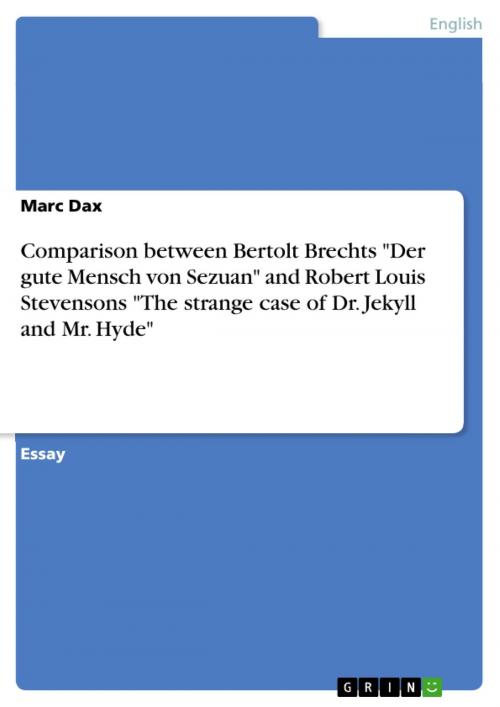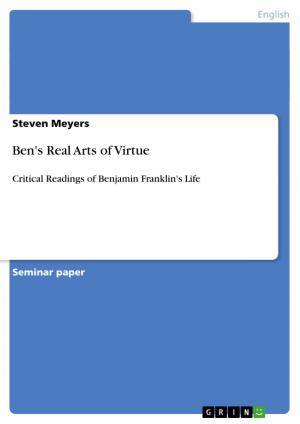Comparison between Bertolt Brechts 'Der gute Mensch von Sezuan' and Robert Louis Stevensons 'The strange case of Dr. Jekyll and Mr. Hyde'
Fiction & Literature, Literary Theory & Criticism, British| Author: | Marc Dax | ISBN: | 9783638519632 |
| Publisher: | GRIN Publishing | Publication: | July 11, 2006 |
| Imprint: | GRIN Publishing | Language: | English |
| Author: | Marc Dax |
| ISBN: | 9783638519632 |
| Publisher: | GRIN Publishing |
| Publication: | July 11, 2006 |
| Imprint: | GRIN Publishing |
| Language: | English |
Essay from the year 2005 in the subject English Language and Literature Studies - Literature, Ruhr-University of Bochum, course: Communication course 2, 7 entries in the bibliography, language: English, abstract: Brecht´s stage play is based predominantly on his own real life experiences and that Brecht needed a long time to develop it. On the other hand Stevenson used nothing but a dream to create his work, and he did so in a very short period of time. Brecht´s Der gute Mensch von Sezuantotally has 10 chapters, in addition you can find a prologue, five interludes and an epilogue. The prologue tells the reader about the three Gods on the way to Sezuan and what they expect of the people. In the interludes the happenings of the former chapter become summerized and the next chapter becomes introduced. The epilogue deals with the expression of an actor, he apologizes that there is no really an end inDer gute Mensch von Sezuan.The audience or the reader have to find their own end, inThe strange Case of Dr. Jekyll and Mr. Hydean end is given. In comparison to Stevensons narrative story, BrechtsDer gute Mensch von Sezuanis a stage play. Although the books are written in two different litterary forms, both introductions strike the point of social setting. The bookThe Strange Case of Dr. Jekyll and Mr. Hyde begins with the first chapter 'Story of the door' where Mr. Utterson is introduced by the narrator: 'Mr Utterson the lawyer was a man of a rugged countenance [...] he drank gin when he was alone' (Stevenson 3). In Der gute Mensch von Sezuanthe beginning is similar. In the prologue Wang introduces himself, he tells the reader that he is a water salesclerk and that the buisness is very hard: 'Ich bin Wasserverkäufer hier in der Hauptstadt von Sezuan. Mein Geschäft ist mühselig. Wenn es wenig Wasser gibt, muß ich weit danach laufen. [...] Aber in unserer Provinz herrscht überhaupt große Armut' (Brecht 7). In both books the introduction does not start with the protagonists, furthermore the introductions already show the reader at the begining whether the protagonists are poor or rich, in what kind of societies the protagonists live and what kind of characters Mr. Utterson and Wang are. The quotations point out at the beginning of both books that Wang is a worker, he has to work hard if he wants to earn money. In contrast Mr. Utterson is a more educated man and he does not need to work as hard as Wang does. The reader sees that in The Strange Case of Dr. Jekyll and Mr. Hyde the protagonists, as well as the other characters are more prosperous than in Der gute Mensch von Sezuan. [...]
Essay from the year 2005 in the subject English Language and Literature Studies - Literature, Ruhr-University of Bochum, course: Communication course 2, 7 entries in the bibliography, language: English, abstract: Brecht´s stage play is based predominantly on his own real life experiences and that Brecht needed a long time to develop it. On the other hand Stevenson used nothing but a dream to create his work, and he did so in a very short period of time. Brecht´s Der gute Mensch von Sezuantotally has 10 chapters, in addition you can find a prologue, five interludes and an epilogue. The prologue tells the reader about the three Gods on the way to Sezuan and what they expect of the people. In the interludes the happenings of the former chapter become summerized and the next chapter becomes introduced. The epilogue deals with the expression of an actor, he apologizes that there is no really an end inDer gute Mensch von Sezuan.The audience or the reader have to find their own end, inThe strange Case of Dr. Jekyll and Mr. Hydean end is given. In comparison to Stevensons narrative story, BrechtsDer gute Mensch von Sezuanis a stage play. Although the books are written in two different litterary forms, both introductions strike the point of social setting. The bookThe Strange Case of Dr. Jekyll and Mr. Hyde begins with the first chapter 'Story of the door' where Mr. Utterson is introduced by the narrator: 'Mr Utterson the lawyer was a man of a rugged countenance [...] he drank gin when he was alone' (Stevenson 3). In Der gute Mensch von Sezuanthe beginning is similar. In the prologue Wang introduces himself, he tells the reader that he is a water salesclerk and that the buisness is very hard: 'Ich bin Wasserverkäufer hier in der Hauptstadt von Sezuan. Mein Geschäft ist mühselig. Wenn es wenig Wasser gibt, muß ich weit danach laufen. [...] Aber in unserer Provinz herrscht überhaupt große Armut' (Brecht 7). In both books the introduction does not start with the protagonists, furthermore the introductions already show the reader at the begining whether the protagonists are poor or rich, in what kind of societies the protagonists live and what kind of characters Mr. Utterson and Wang are. The quotations point out at the beginning of both books that Wang is a worker, he has to work hard if he wants to earn money. In contrast Mr. Utterson is a more educated man and he does not need to work as hard as Wang does. The reader sees that in The Strange Case of Dr. Jekyll and Mr. Hyde the protagonists, as well as the other characters are more prosperous than in Der gute Mensch von Sezuan. [...]















